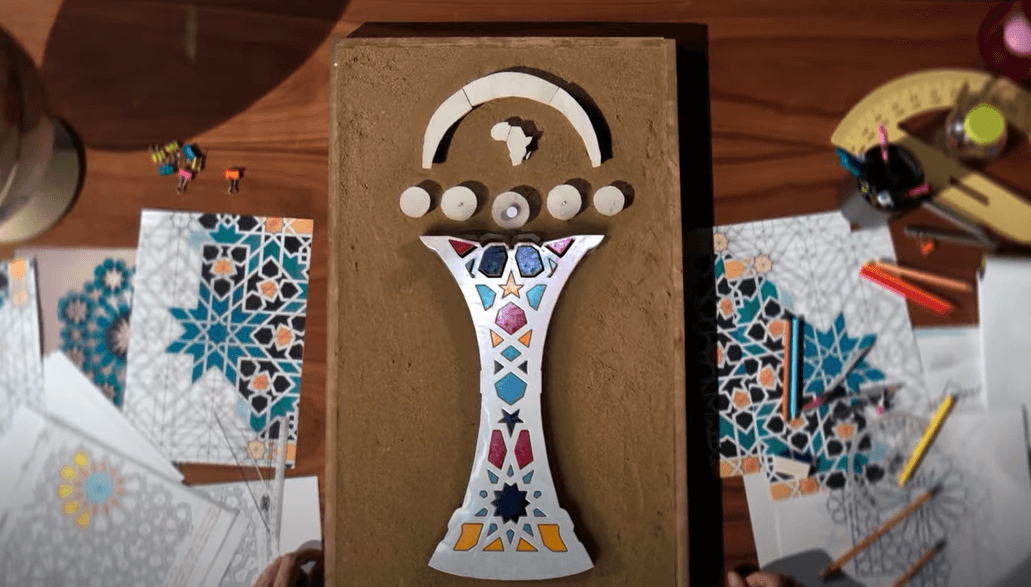After the issue of the Algerian national team's shirt created by Adidas, Moroccan zellige is once again at the center of a new controversy. The logo of CAN 2025 in Morocco, inspired by Moroccan zellige, irritates our Algerian neighbors. Mounir Akasbi, an archaeologist and cultural heritage specialist at Sidi Mohamed Ben Abdellah University in Fez, analyzes the 100% Moroccan origins of this legacy and states that the logo is "authentic and its reference is the Zellige fassi.
Unveiled last Saturday in Rabat, the official logo of CAN 2025 containing motifs of Moroccan zellige has not been well received by our Algerian neighbors. Their media have once again pointed the finger at Morocco, confusingly associating zellige with Algeria through football
It seems that, in light of the clip presented (...), the association of zellige with Algeria through football has not yet been accepted by our neighbors,” wrote the media outlet DZ Foot, before emphasizing that zellige is an “ornamental mosaic typical of North Africa found in both Tlemcen (in Algeria, ed.) and Kairouan (in Tunisia, ed.).” And therefore, not only in Morocco...
The Algerian press refers to the issue of the Adidas shirt that sparked the discord. The use of Moroccan zellige on Algerian jerseys had created a major controversy in Morocco, to the point where the Ministry of Culture threatened to take legal action. Adidas then withdrew the jerseys and issued official apologies to Morocco to avoid the lawsuit
The logo of CAN 2025 in Morocco, inspired by Moroccan zellige, irritates our Algerian neighbors who consider it to be a “typical ornamental mosaic of North Africa… and not of Morocco.” What do you think about this debate?
Zellige is a decorative motif for wall and floor coverings that has been documented in Morocco since the 12th century. Its main manufacturing centers were primarily in Fez and, from the 16th century onwards, in Tetouan. The zellige from Fez is the most famous due to its intricacy and variety of shapes. It is worth noting that this industry has never ceased to operate from the medieval era to the present day, and its knowledge has been passed down from generation to generation, representing a significant asset in terms of heritage value
Furthermore, the knowledge, skills, and technical expertise related to zellige production are very much present in the workshops and do not face risks of disappearance. Thus, young people learn the craft and bring many ideas for renewal in terms of patterns and compositions.
The pieces used by the designer are well-known in the zellige of Fez, such as nejma, derham, ktib, etc. The color composition resembles the highly diversified Moroccan zellige panels like: مخبل, العقول, والعنكبوت والناعورة والقطيب بالبوشون. That said, the logo is undeniably authentic and its reference is indeed the zellige from Fes.
The words zellige or azulejos used in Algeria or Spain refer more to larger tiles, most of which are produced in factories and are not handmade like ours
Algeria also wishes to inscribe zellige on the UNESCO World Heritage list. Why is zellige not yet listed as UNESCO World Heritage on behalf of Morocco?
The candidacy file for Moroccan zellige is ready to be submitted to UNESCO, just like that of the caftan ntaa النطع, but unfortunately, according to the rules of this organization, each member state is not allowed to propose more than one file every two years. Morocco has registered several elements of our heritage with the global intellectual property protection organization, including zellige, and advocates through its permanent delegation at UNESCO for national interests in consultation with Moroccan experts and the Ministry of Culture.
Recently, we have seen abusive use of certain forms of Moroccan cultural heritage by other countries without referencing our country. How can we address these attempts at usurpation?
Moroccan zellige is known worldwide. The evidence lies in the growing export numbers of this craft globally. The UNESCO declaration will be nothing more than a recognition of this undeniable value of Moroccan civilization.
Attempts at usurpation or, rather, the use of certain elements or models to strengthen some candidacy files at the UNESCO level adds more shine and celebrity to our heritage because the forms of intangible heritage in Morocco are alive, and the millions of tourists who come to our country experience and appreciate them.
What do you think of the new anti-usurpation law project No. 33.22 recently proposed by the Minister of Youth, Culture, and Communication, Mohamed Mehdi Bensaid?
Law 33.22 complements Law 22.80 for new forms of heritage, such as underwater heritage and, above all, intangible heritage and living human treasures. This will help establish the legal foundations to declare certain forms as national heritage.
Article source: lobservateur






